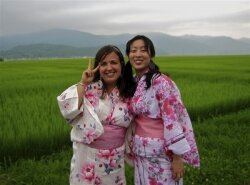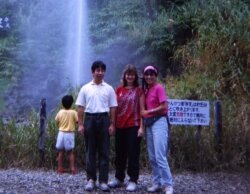Shaken ground: Sendai left deep impressions
We arrived in Sendai in June. It was early summer, not too hot, and this city of a million welcomed us in its own way. Quietly, people helped my husband and me find an apartment, a recycle shop for furniture, and food markets on the narrow neighborhood streets. We heard piano from an open window, birdsong in a bamboo grove, and lyrical voices conversing in Japanese.
Although our neighborhood felt like a small town, downtown was all big city: bustling streets, crowded sidewalks, and gleaming skyscrapers. Buses sped by with their destinations written in Japanese kanji. Unable to read kanji, I soon got a one-speed bicycle, and rode twenty minutes each day to the New Day School where I taught English.
A month earlier I had left graduate school at Michigan, and I wanted to experience another culture while I struggled to determine what to do in my own. Japan beckoned, a prime destination for those eager to work abroad.
Like most visiting teachers, we lived in a modest one-bedroom apartment with tatami mat floors and thin walls. We furnished it in traditional style, folding up our futon each day and taking meals at a low-lying table with our legs crossed.
It took no time to discover the neighborhood restaurants, the noodle shop and the Chinese place, the sushi on a conveyor belt and the western style coffee shop. The flavors of ginger and miso were as intoxicating as the saké. We learned to order by pointing at the plastic food in the window outside or at the few kanji we recognized, like “chicken.”
An American colleague introduced us to his two closest Japanese friends, Hiroko and Shoh. They invited us to visit an onsen, or outdoor hot spring, where people soak, relax, and socialize. We drove through a countryside speckled with rice fields against a backdrop of blue-green mountains. Nestled into the hillside was a traditional Japanese building made of light wood beams and inner walls of rice-paper.
It was there I learned the meaning of the phrase "hadaka no tsukiai,” or “the closeness of friends naked." We sat among dozens of men and women in steaming tubs and admired the mountains above us. I didn’t consider that the heat for these springs rose through fissures in the tectonic plates. The earth seemed firm and permanent under our feet.
I was invited to join a flower-arranging (ikebana) class, where I learned how to place flowers by calculating their relative angles, balance wild and domestic blossoms, and appreciate the subtle hierarchy of the art. Just as I was given great respect as an English teacher, I was expected to show the same for my ikebana teacher. In all their endeavors, people paid handsomely to take lessons, and they studied diligently for years as they progressed with their English skills, flower arranging, karate, or music.
Our friendships with Shoh and Hiroko deepened. Hiroko, a charming and adventurous widow, often hosted us in her home or on countryside excursions. Our friends shared sushi, explained social conventions, and defended the latest Japanese fad.
A job offer from UVa in 1989 pulled us back home, where we hosted first Hiroko and, later, Shoh.
Since then, my image of Sendai and its people has endured unchanged in my photos, videos, journals, and memory.
Until March 11. Now I see Sendai on TV as the rest of the world does—as a place where nature has brought her greatest fury to bear and changed in an instant what took decades to create.
But just as those waves of images had numbed me, I heard of the first confirmed death of an American, a woman who had graduated from the college where I teach. Now instead of watching thousands of dots swept up in the currents, I saw the face of one young woman, Taylor Anderson, whom I’d last seen smiling among her friends on campus.
It’s no coincidence that she had been a teacher, for teaching is the most common way for foreigners to live among the Japanese. Taylor, a Virginia native, had been working in the Japan Exchange and Teaching (JET) program. She was one of over 50,000 Americans who’ve experienced the country through JET, joining thousands more who’ve worked at private language schools as I did. These teachers speak each day with Japanese people, sharing stories in the classroom, then joining them for play after hours. Like the Peace Corps, the JET program builds lasting relationships and leaves deep cultural impressions.
Even as Taylor is mourned by her family in Chesterfield, by her former classmates and professors at Randolph-Macon College, and by her sisters at Alpha Gamma Delta, she is also remembered by those she touched in Ishinomaki, where she was last seen helping her students evacuate with their parents before the tsunami swept through. Although the residents of Ishinomaki have lost families and homes, I’m certain they also feel deeply the loss of Taylor, who lived among them for three years.
I’m left guessing how my own friends in Sendai have fared. Our apartment was on the ocean side of the city, a modest two-story building. I’m sure that house is gone now, and wonder what happened to the landlady who took such good care of us, Numakura-san. We’ve been unsuccessful reaching Hiroko, though her house on a hill was likely spared.
I imagine those streets, and the water washing them away, leaving behind all the little things on the shaken ground. But I also hope that in the years ahead, the ties that bind our two peoples will help make the world feel stable once more.
~
Gayla Mills lives in Richmond, teaches English at Randolph-Macon College, and writes.

